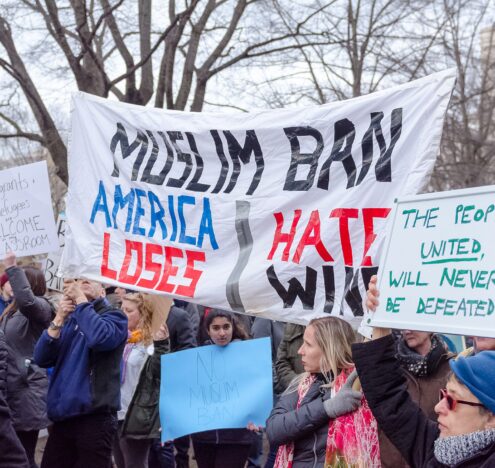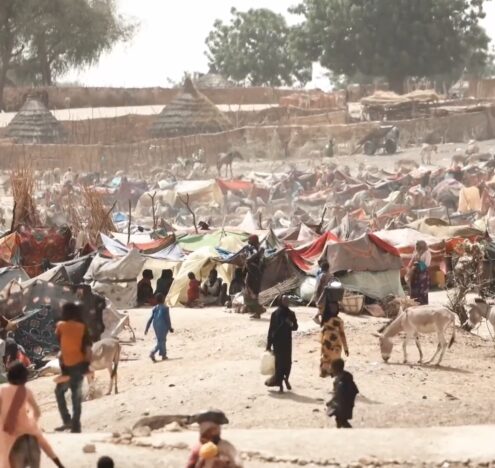“Adults in a Room” is a series in collaboration with The Atlantic Council’s New American Engagement Initiative (NAEI). The series stems from NAEI’s monthly networking events that call on analysts to gather virtually and hash out a salient topic. This series aims to give you a peek into their Zoom room and a deep understanding of the issue at hand in less than the time it takes to sip your morning coffee, without the jargon, acronyms, and stuffiness that often come with expertise.
This year marks the 75th anniversary of the Marshall Plan, which aimed to revive the economic output in Western European countries and allow for the United States to disengage from Europe eventually. Unfortunately, while economic recovery took place, the United States became more intertwined with the security apparatuses of Western Europe. Today, we see a similar dynamic play out with much of the humanitarian assistance and development aid that the United States contributes to other countries. Rather than making these countries more independent, the current aid model maintains the status quo power dynamic, creating a neocolonial relationship between recipient and donor countries. What are the overlooked lessons from the Marshall Plan and its legacy on US international assistance? How can international assistance be reformed to be more effective at uplifting people and creating lasting change?
The Atlantic Council’s New American Engagement Initiative’s (NAEI) June roundtable brought experts together to discuss the anniversary of the Marshall Plan and the state of international assistance. Participants discussed the relative efficacy of the Marshall Plan and how the memory of the program hangs over international policy today. The discussion also covered the neocolonial relationships created by the assistance model and the dangers of the United States trying to achieve geopolitical ends through international assistance, picking winners and losers in the process. Four of the participants shared their takeaways from the discussion below.
Marc Frey, Nonresident Senior Fellow, New American Engagement Initiative, Atlantic Council
It seems that every new international conflict is accompanied by calls for a “new” Marshall Plan. Unfortunately, these calls often misunderstand what made the actual Marshall Plan successful — and why. In particular, advocates of a new Marshall Plan — who happen to be proponents of foreign assistance — focus only on the economic side of the equation, neglecting the security side. But without accompanying gains in security and stability, foreign aid — no matter how generous — will not produce long-term, sustainable results.
Promoting partnership through investment and redistribution of wealth, essentially decolonizing wealth, is an ideal scenario to strive toward rectifying the damaging legacies of colonialism.
Proponents of a New Marshall Plan also tend to forget that participants in the original had to agree to several political and economic conditions to receive the funds. Since 1947, the United States has continued to impose conditions on its foreign aid to maximize its influence and promote US objectives, from containing communism and countering narcotics to fighting terrorism and improving global health. However, that conditionality has generally failed to deliver the desired outcomes. Moreover, it certainly has failed to achieve its larger purpose, as stated by the US Agency of International Development (USAID): that the intended end of foreign aid is its elimination.
It’s not hard to see why this conditionality hasn’t worked. First, the conditions, such as provisions designed to ensure that assistance is not diverted, are rarely enforced. For example, conditions often prohibit or limit assistance to countries viewed as having significant corruption challenges. In Afghanistan, however, US assistance continued to flow despite credible accusations of corruption. Similarly, aid withheld because of human rights concerns, as was recently the case in Egypt, is often a small fraction of the total assistance package. Finally, many fund sources and/or have “notwithstanding” and/or waiver provisions that dilute the impact of any conditions or restrictions.
Second, in an increasingly fragmented landscape, many assistance sources exist, including US competitors. For example, the Malians turned elsewhere when the United States suspended military aid to Mali in 2020 following the coup in that country. As long as aid recipients have other options and can play donors off of one another, US leverage to enforce conditions will be limited.
Third, the conditions may be counterproductive to the larger objectives. For example, the threat to withhold aid to a government could benefit spoilers, and other actors whose survival and power depend on continued instability and violence, such as when the United States suspended support to the Somali National Army in its battle against al Shabaab.
Still, despite these challenges, “development” will continue to be one of the three “Ds” that make up US foreign policy (along with diplomacy and defense), and the United States will continue to provide billions in conditions-based assistance. To be more successful, the United States should transition from simply attaching generic conditions to making the specific development “deal” up front and tailored to local realities. Ideally, this deal would recognize that the conflict or crisis has its own internal political and commercial economy. By delivering assistance, the United States becomes a player in that economy, explicitly or implicitly benefitting some at the real or perceived expense of others. Local actors are hyper-aware of these dynamics and will seek to reap the gains for their side. The United States must understand these dynamics, too, and ensure that that knowledge informs its deal-making.
Aude Darnal, Associate Director, New American Engagement Initiative, Atlantic Council
Policymakers and scholars should pay more attention to the operationalization of international assistance and how it is delivered to target countries. Working in the peacebuilding and humanitarian sectors in West Africa exposed me to a reality that deserves scrutiny by those in government and other major funders. When assistance is not directly provided to governments, it is primarily channeled through external actors like multilateral organizations and the program they implement. While donors are increasingly calling for more localization and domestic ownership of assistance, most of these actors work within a framework based not on local needs and contexts but on a Western understanding of what these are.
Though the reliance on local employees varies, Westerners predominantly occupy leadership positions at the country, regional, and HQ level, meaning that they traditionally lead and design ― and to some extent execute ― analyses, strategies, tools, and programs. External actors thus relegate to the background of decision processes local actors engaged in change. This is not right.
To render international assistance more efficient and respectful of local actors, external stakeholders should let local actors lead change and exert control over programs, which will ensure that programs answer actual needs, encourage sustainability, and reduce aid dependency.
International assistance has become a business that does not empower local champions of change enough to fully take the lead in preventing and solving crises and developing their countries. According to a Development Initiatives report, in 2020, only 3.1% of humanitarian funding directly went to local and national actors, far below the target of 25% by 2020 set by the Grand Bargain. Additionally, while we know that most of the funding is channeled through foreign organizations, there is a lack of data and transparency on the volume of capital transferred from these to their local partners and target populations. For example, a survey by Development Initiatives about Irish Aid’s response to the 2015 Nepal earthquake reveals that 11.6% of Trócaire’s budget ― one of Irish Aid’s international beneficiaries ― funded HQ and international staff associated costs. By systemically relegating local actors to the background of aid decisions and design processes, international actors dismiss local expertise and enable the money to partly circle back to Western economies by acting as donors and implementers of assistance.
To render international assistance more efficient and respectful of local actors, external stakeholders, from donors to operators, such as INGOs, must take a step back. They should truly let local actors lead change and exert control over programs, from design and implementation to monitoring and evaluation. This will ensure that programs answer actual needs, encourage sustainability, and reduce aid dependency. Rather than viewing them as beneficiaries, donors should consider assistance recipients as partners and seek to embrace a strategy closer to that of project incubator rather than mere delivery of aid.
Finally, limited local capacity in some contexts should not be used as an excuse to continue with the status quo and overlook domestic knowledge and power of innovation. Instead, donors and traditional external implementers ― INGOs and corporate organizations ― should commit to partnering with local stakeholders to help them overcome technical and technology gaps they may encounter in designing and implementing programs.
It is not an easy or rapid task, but neither is positive change.
Elana Aquino, US Executive Director, Peace Direct
Taking as normative the concept that no one human nor nation is more entitled to a prosperous, peaceful existence than another, the fissures in the system that preference some nations as giving nations and some nations as receiving nations become visible. Systemic change is required to stem the centuries-long tide of inequity and power imbalance that keeps individuals and nations trapped in this artificial, inauthentic, and inefficient relationship with one another. In Time to Decolonise Aid, Global South community-based leaders provide clear recommendations on the way forward to advance the generational work of decolonization at the individual, INGO, donor, and policymaker levels. It is about, among other things, the harmful norms we continue to ascribe to through our language, attitudes, sense of entitlement and privilege, and practices.
Promoting partnership through investment and redistribution of wealth, essentially decolonizing wealth, is an ideal scenario to strive toward rectifying the damaging legacies of colonialism. An interim approach can be something similar to what Peace Direct is pioneering with our Local Action Fund model. Through the local action fund model, we preference values of flexibility, inclusion, respect, sustainability, and trust in funding, called FIRST funding. This highly scalable approach gives us the ability to codesign the outcomes and support partners in a more adaptive way and lays the groundwork for reciprocal alliance building.
Whether it’s support to partners working to overcome inter-religious and ethnic tensions in Pakistan and Nigeria or partners promoting the cessation of gender-based violence and uplifting social cohesion in Myanmar, many of the projects are designed and run by people with lived experience, keeping the decision making and ownership with the groups who are embedded in the communities affected by the conflict, increasing credibility and relevance.
Amin Mohseni-Cheraghlou, Macroeconomist, Atlantic Council’s GeoEconomics Center
The world’s population is aging. The share of people ages 65 and above in the world’s total population has increased from around 5% in 1960 to near 10% in 2020. It is projected that by 2050, one in six people (or 16% of the world’s population) will be 65 and older. As societies age, aggregate demand will decrease, growth will slow down, and support costs for the elderly population will increase, such as higher medical, care, and retirement costs. All of these will put pressure on government budgets as tax revenues decline and government expenses on old-age benefits increase. This will pressure governments to increase tax rates and cut spending, exacerbating economic slowdown.
Today, nearly three-fourths of the world’s 2 billion youth population (ages 15 and below) reside in low-income and lower-middle-income economies situated mainly in sub-Saharan Africa, South Asia, and Southeast Asia regions. The global economy needs some sort of a “Marshall Plan” directed toward these economies, which host the world’s youth, to avoid prolonged a period of slowdown — or even recession. The most appropriate mechanism for such large-scale investment across various countries and regions would be through the World Bank Group, where sovereigns such as the United States and other advanced economies can allocate funds for this purpose. Moreover, through various guarantee and insurance/re-insurance mechanisms provided by the World Bank and the fact that public infrastructure investments can crowd-in private investment, such projects can attract private capital. For this to happen, the United States and other major shareholders of the World Bank need to implement relevant reforms at this institution.
Increasing the income of these economies will translate to the ability of their young population to consume more as they grow older and establish their careers and families. This will increase the demand for consumers and capital goods in the global economy for at least the next five decades, helping offset the downward pressure on global aggregate demand due to rapidly aging populations in high-income and upper-middle-income economies. In other words, the economic development of low-income and lower-middle income economies in sub-Saharan Africa, South Asia, and Southeast Asia is tantamount to safeguarding the global economy from entering a long period of low growth rates for decades to come.





















